- Luật
- Hỏi đáp
- Văn bản pháp luật
- Luật Giao Thông Đường Bộ
- Luật Hôn Nhân gia đình
- Luật Hành Chính,khiếu nại tố cáo
- Luật xây dựng
- Luật đất đai,bất động sản
- Luật lao động
- Luật kinh doanh đầu tư
- Luật thương mại
- Luật thuế
- Luật thi hành án
- Luật tố tụng dân sự
- Luật dân sự
- Luật thừa kế
- Luật hình sự
- Văn bản toà án Nghị quyết,án lệ
- Luật chứng khoán
- Video
- NGHIÊN CỨU PHÁP LUẬT
- ĐẦU TƯ CHỨNG KHOÁN
- BIẾN ĐỔI KHÍ HẬU
- Bình luận khoa học hình sự
- Dịch vụ pháp lý
- Tin tức và sự kiện
- Thư giãn

TIN TỨC
fanpage
Thống kê truy cập
- Online: 223
- Hôm nay: 198
- Tháng: 1621
- Tổng truy cập: 5245625
LỜI BÁO ĐỘNG CỦA HÀNH TINH TRÁI ĐẤT 8 2021 119
Lời dẫn : 1/9/2021
số phát hành tháng 8 2021 ngày 23 của tờ TIME đã dành cho chủ đề thảm họa biến đổi khí hậu đang xãy ra toàn cầu như Lời báo động khẩn cấp của hành tinh Trái đất đến mỗi con người chúng ta .
. Biến đổi khí hậu, đã là nguyên nhân của thời tiết khắc nghiệt . Với TP hồ chí Minh và Đồng bằng sông Cửu Long chắc chắn đang trở nên tồi tệ năm 2030 và rất thảm họa 2035. Ngay cả khi thế giới kỳ diệu ngừng phát khí nhà kính từ năm 2021 hôm nay, những khí ,rác thải ..trong bốn mươi năm qua sẽ tiếp tục ảnh hưởng phá hoại nghiêm trọng đến bầu khí quyển của Trái đất cho đến giữa thế kỷ 21. Vì lý do này, việc giải quyết vấn đề biến đổi khí hậu phải được xem như là thách thức lớn nhất và quan trọng nhất trong hai mươi năm tiếp theo.
Trung tuần tháng 7, hai quốc gia châu Âu phát triển hàng đầu là Đức và Bỉ - chưa kể Áo, Hà Lan cũng chịu tác động ít nhiều - đã trải qua đợt lũ lụt lịch sử. Mưa lụt trái mùa lớn chưa từng thấy trong gần 100 năm qua đã khiến gần 200 người thiệt mạng. Con số vẫn chưa dừng lại vì có đến hơn 1.500 người đang mất tích. Chưa kể đường sá, cầu cống, nhà cửa, xe cộ… bị cuốn theo dòng lũ. Đến mức mà bà Thủ tướng Đức Angela Merkel đang thăm Mỹ trong chuyến đi cuối cùng với tư cách thủ tướng và để nhận bằng tiến sĩ danh dự Đại học Johns Hopkins, đã vội vã về nhà, đến thăm vùng thảm họa để tận mắt chứng kiến những thiệt hại mà bà gọi là “siêu thực, ám ảnh”, hứa hẹn tái thiết và kêu gọi cùng hành động phòng chống biến đổi khí hậu.
Canada thì ngược lại, đang đối diện với đợt nắng nóng kinh hoàng. Cũng là cái gì đó rất trái với quy luật tự nhiên trước nay. Tại một vùng cho đến nay hầu như chỉ biết đến tuyết rơi và những mùa hè mát mẻ, nhiệt độ đột ngột tăng lên 49,6 độ C như ở Trung Đông, hay sa mạc Sahara. Hơn 700 người Canada đã thiệt mạng vì nắng nóng. Ở bang Oregon, Mỹ, ít nhất có 95 người chết do đợt nắng nóng kỷ lục, còn ở bang Washington cũng có hàng chục người chết vì nóng.
Mưa và nắng ở mỗi vùng đất đã hình thành quy luật từ xa xưa. Giờ đây, cái quy luật đó đang bị phá vỡ và Trái đất đang ở một thời kỳ biến động khó lường - theo nhiều nhà khoa học về khí hậu. Một dự thảo báo cáo bị rò rỉ của Ủy ban Liên chính phủ về Biến đổi khí hậu (IPCC) của Liên Hiệp Quốc (dự kiến công bố đầu năm 2022), cảnh báo rằng biến đổi khí hậu sẽ định hình lại một cách căn bản sự sống trên Trái đất trong những thập kỷ tới, ngay cả khi con người chế ngự được lượng khí thải gây hiệu ứng nhà kính đang làm hành tinh nóng lên.
Trích đoạn báo cáo IPCC (theo bản dịch trên trang web Hành tinh Titanic): “Sự tuyệt chủng của các loài, dịch bệnh lan rộng, sốc nóng không sống nổi, hệ sinh thái sụp đổ, các thành phố bị đe dọa bởi nước biển dâng - những tác động này và các tác động khí hậu tàn khốc khác đang tăng tốc và chắc chắn sẽ trở nên rõ ràng trước khi một đứa trẻ sinh ra ngày hôm nay bước qua tuổi 30”.
Các lựa chọn mà xã hội đưa ra hiện nay sẽ quyết định liệu loài người có tiếp tục thịnh vượng, hay chỉ đơn giản là sống sót khi vượt qua thế kỷ XXI.
“Điều tồi tệ nhất vẫn còn ở phía trước, nó sẽ ảnh hưởng đến cuộc sống của con cháu chúng ta nhiều hơn là của chính chúng ta”, báo cáo viết.
Kết luận quan trọng thứ hai của bản báo cáo: thế giới phải đối mặt với thực tế này và chuẩn bị cho cuộc “thanh trừng” dữ dội của biến đổi khí hậu. “Các mức độ thích ứng hiện tại không đủ để ứng phó với các rủi ro khí hậu trong tương lai”, báo cáo cảnh báo.
Các dự báo cho thời điểm giữa thế kỷ này - ngay cả trong một kịch bản lạc quan là ấm lên chỉ 2 độ C - cho thấy cảnh báo trên vẫn chỉ là đang nói giảm/nói tránh.
Hàng chục triệu người có khả năng phải đối mặt với nạn đói vào năm 2050, và 130 triệu người nữa có thể trải qua tình trạng nghèo cùng cực trong vòng một thập kỷ nếu tình trạng bất bình đẳng gia tăng.
Vào năm 2050, các thành phố ven biển nằm trên “chiến tuyến” của cuộc khủng hoảng khí hậu sẽ chứng kiến hàng trăm triệu người bị đe dọa do lũ lụt và các cơn bão biển ngày càng ác liệt vì nước biển dâng. Khoảng 350 triệu người sống ở các khu vực thành thị sẽ phải chịu cảnh khan hiếm nước do hạn hán nghiêm trọng khi nhiệt độ tăng 1,5 độ C; con số này sẽ là 410 triệu người khi mức tăng nhiệt là 2 độ C.
Thêm nửa độ cũng có nghĩa sẽ có thêm 420 triệu người tiếp xúc với những đợt nắng nóng khắc nghiệt có khả năng gây chết người.
Cách nay 60 năm ,vào đầu thập kỷ 60 có bài hát the end of the World của Skeeter Davis ( 1962 Nhâm dẦN ) . Bài hát nhẹ nhàng với câu hỏi Why .Rất tuyệt .
Why does the sea rush to shore?
Don't they know it's the end of the world?
'Cause you don't love me any more
Why do the stars glow above?
Don't they know it's the end of the world?
It ended when I lost your love
Why everything's the same as it was
I can't understand, no, I can't understand
How life goes on the way it does
Why do these eyes of mine cry?
Don't they know it's the end of the world?
It ended when you said, "Good-bye"
(Why do these eyes of mine cry?)
Mmm, mmm, mmm
Don't they know it's the end of the world?
It ended when you said, "Good-bye"
Sao mặt trời lại cứ tỏa sáng?
Sao biển cả vẫn xô bờ?
Chúng ko biết rằng đã tận thế rồi ư,
Vì anh ko còn yêu em nữa
Sao những chú chim vẫn cứ hát ca?
Sao những vì sao vẫn rực sáng trên ko?
Chúng ko biết rằng đã tận thế rồi ư
Đã kết thúc rồi khi em đánh mất tình yêu
Em thức dậy vào sáng sớm và tự hỏi mình,
Tại sao mọi việc cứ diễn ra như nó vẫn vậy
Em ko thể hiểu được.ko,em ko thể hiểu nổi
Sao cuộc sống vẫn mãi tiếp diễn theo cách ấy
Sao con tim này vẫn đập?
Sao những giọt nước mắt này lại tuôn rơi?
Chúng ko biết đã tận thế rồi ư
Đã chẳng còn gì từ khi anh nói lời chia tay.
Sao con tim này vẫn đập?
Sao những giọt nước mắt này lại tuôn rơi?
Chúng ko biết đã tận thế rồi ư
Đã chẳng còn gì từ khi anh nói lời chia tay.
Nowhere is the nascent climate crisis more dramatic than in the West, where drought and extreme heat have created life-threatening conditions.
Không ở đâu cuộc khủng hoảng khí hậu mới xuất hiện lại gay gắt hơn ở phương Tây, nơi mà hạn hán và nắng nóng khắc nghiệt đã tạo ra những điều kiện đe dọa tính mạng.
Keethan Tsosie, 9, swims off Lone Rock Beach in Lake Powell while visiting from the Many Farms, Ariz., area of the Navajo Nation on June 12. Hovering at around just 32% of capacity as of Aug. 14, America’s second largest reservoir has reached a low unseen since it was being filled in the 1960s. Over the past year, the water level dropped some 52 ft. The U.S. Bureau of Reclamation has begun a plan to release water from upstream reservoirs in a bid to keep Lake Powell above a level that would threaten hydropower generation at Glen Canyon Dam.
Keethan Tsosie, 9 tuổi, bơi ra khỏi Bãi biển Lone Rock ở Hồ Powell trong khi đến thăm từ Many Farms, Ariz., Khu vực của Navajo Nation vào ngày 12 tháng 6. Chỉ bay lơ lửng với 32% dung tích tính đến ngày 14 tháng 8, hồ chứa lớn thứ hai của Mỹ đã đạt mức thấp chưa từng thấy kể từ khi nó được lấp đầy vào những năm 1960. Trong năm qua, mực nước đã giảm khoảng 52 ft. Cục Khai hoang Hoa Kỳ đã bắt đầu kế hoạch xả nước từ các hồ chứa ở thượng nguồn nhằm giữ cho Hồ Powell ở trên mức có thể đe dọa sản xuất thủy điện tại Đập Glen Canyon.
This project was supported by the Pulitzer Center. Dự án này được hỗ trợ bởi Trung tâm Pulitzer.
The reality of climate change is unequivocal, its effects are already playing out in every region of the planet, and we need to act now before the outlook gets worse. That was the warning message from the U.N. Intergovernmental Panel on Climate Change (IPCC) in a 4,000-page report, published Aug. 9, which laid out in methodical detail the ways in which human activity has set life on the planet on a collision course.
The U.N.'s climate-science body couldn’t have been more clear: if we continue to emit greenhouse gases at current rates, the effects of climate change will be catastrophic and irreversible. “Recent changes in the climate are widespread, rapid and intensifying—unprecedented in thousands of years,” says Ko Barrett, a vice chair of the IPCC.
Thực tế của biến đổi khí hậu là rõ ràng, các tác động của nó đã và đang diễn ra ở mọi khu vực trên hành tinh, và chúng ta cần phải hành động ngay bây giờ trước khi triển vọng trở nên tồi tệ hơn. Đó là thông điệp cảnh báo từ Ủy ban Liên chính phủ về Biến đổi Khí hậu (IPCC) của Liên hợp quốc trong một báo cáo dài 4.000 trang, được công bố ngày 9/8/2021, trình bày chi tiết một cách có phương pháp các cách thức mà hoạt động của con người đã thiết lập sự sống trên hành tinh trong một quá trình va chạm. .
](https://assets.time.com/extreme-heat-drought/static/img/cover.jpg)
After the Dixie Fire in Indian Falls, Calif., in July. Get a print of TIME's cover.
It’s a revelation shocking to read and perhaps painfully obvious for the countless people who are already feeling the effects—from Germans whose homes were wiped away by floods this year to farmers suffering from ongoing drought in Central America. In the U.S. the nascent climate crisis appears most dramatic in the West, where a combination of drought and extreme heat has created life-threatening conditions.
TIME sent photographer Adam Ferguson on the road across six Western states—from Arizona to Washington—for more than five weeks in June and July to document how climate change is shaping life on the ground. He captured images of empty reservoirs and families who lost loved ones to unbearable heat. He encountered farmers worried about watering their crops and saw the devastation left by wildfires. It’s a searing warning from a particularly iconic region on a planet that is, in so many places, on fire, parched or underwater.
Cơ quan khoa học khí hậu của Liên hợp quốc không thể rõ ràng hơn: nếu chúng ta tiếp tục phát thải khí nhà kính với tốc độ hiện tại, tác động của biến đổi khí hậu sẽ rất thảm khốc và không thể đảo ngược. Ko Barrett, phó chủ tịch của IPCC cho biết: “Những thay đổi gần đây trong khí hậu đang diễn ra phổ biến, nhanh chóng và ngày càng gia tăng - chưa từng có trong hàng nghìn năm”.
Sau đám cháy Dixie ở Indian Falls, California, vào tháng Bảy. [Nhận bản in bìa của TIME.] (Https://timecoverstore.com/featured/what-happens-to-the-planet-next-is-up-to-us-photograph-by-adam-ferguson-for- time)
Sau đám cháy Dixie ở Indian Falls, California, vào tháng Bảy. Nhận bản in bìa của TIME.
Đó là một tiết lộ gây sốc khi đọc và có lẽ rõ ràng một cách đau đớn đối với vô số người đã và đang cảm thấy những ảnh hưởng — từ những người Đức có nhà cửa bị lũ quét sạch trong năm nay đến những người nông dân đang phải chịu đựng hạn hán đang diễn ra ở Trung Mỹ. Tại Hoa Kỳ, cuộc khủng hoảng khí hậu sơ khai xuất hiện nghiêm trọng nhất ở phương Tây, nơi sự kết hợp của hạn hán và nắng nóng khắc nghiệt đã tạo ra các điều kiện đe dọa tính mạng.
TIME đã cử nhiếp ảnh gia Adam Ferguson đi khắp sáu bang miền Tây — từ Arizona đến Washington — trong hơn năm tuần vào tháng 6 và tháng 7 để ghi lại cách biến đổi khí hậu đang định hình cuộc sống trên mặt đất. Anh chụp lại hình ảnh những hồ chứa nước trống rỗng và những gia đình mất người thân vì cái nóng không thể chịu nổi. Anh bắt gặp những người nông dân đang lo lắng về việc tưới nước cho cây trồng của họ và chứng kiến sự tàn phá do cháy rừng để lại. Đó là một lời cảnh báo nhức nhối từ một khu vực đặc biệt mang tính biểu tượng trên một hành tinh, ở rất nhiều nơi, đang bốc cháy, khô cằn hoặc dưới nước.
 since record keeping began in 1847.](https://assets.time.com/extreme-heat-drought/static/img/large/AF_USA_Heat_2021_02271.jpg)
Near Central, Utah
Farmhand and local watermaster Richard Crockett checks the level of a canal on June 11. “Our water situation has never been this bad,” says Crockett, 78. “Right now, everybody’s praying for rain. But the forecasters say we’re not going to get any,” he adds. “Most farmers and ranchers in this area are facing extinction.” Up north, part of the Great Salt Lake dropped to its lowest level since record keeping began in 1847.
"YOU CAN'T RAISE ANIMALS WITHOUT WATER."
Ông Crockett, 78 tuổi, cho biết: Farmhand và quản lý nước địa phương kiểm tra mực nước của một con kênh vào ngày 11 tháng 6. “Tình hình nước của chúng tôi chưa bao giờ tồi tệ như thế này. Nhưng các nhà dự báo nói rằng chúng tôi sẽ không nhận được bất kỳ điều gì, ”ông nói thêm. “Hầu hết nông dân và chủ trang trại trong khu vực này đang phải đối mặt với nguy cơ tuyệt chủng.” Ở phía bắc, một phần của Hồ Muối Lớn đã giảm xuống mức thấp nhất kể từ khi việc lưu trữ kỷ lục bắt đầu vào năm 1847.
"BẠN KHÔNG THỂ NUÔI CON VẬT MÀ KHÔNG CÓ NƯỚC."
 on July 13, had burned more than 554,000 acres by Aug. 15 and was only 31% contained.](https://assets.time.com/extreme-heat-drought/static/img/large/AF_USA_Heat_2021_11185.jpg)
Near Crescent Mills, Calif.
Firefighters stand for a portrait while fighting the Dixie Fire, the largest single fire in California's history, on July 25. The blaze, which started on July 13, had burned more than 554,000 acres by Aug. 15 and was only 31% contained.
Các nhân viên cứu hỏa đứng cho một bức chân dung trong khi chiến đấu với Đám cháy Dixie, đám cháy lớn nhất trong lịch sử của California, vào ngày 25 tháng 7. Ngọn lửa, bắt đầu vào ngày 13 tháng 7, đã thiêu rụi hơn 554.000 mẫu Anh vào ngày 15 tháng 8 và chỉ được kiềm chế 31%.
 and went undetected for days before July 6, when it was reported. The fire, which for a time was America’s largest of the year, burned more than [413,000 acres](https://inciweb.nwcg.gov/incident/7609/) and led to the evacuation of [some 2,000 homes](https://apnews.com/article/science-fires-environment-and-nature-wildfires-3f102582aa78c2400a95374a2fb07529). By Aug. 15, it was 100% contained.](https://assets.time.com/extreme-heat-drought/static/img/large/AF_USA_Heat_2021_10409.jpg)
Fremont-Winema National Forest, Ore.
In advance of the Bootleg Fire's approach on July 23, a structure was wrapped in fire-retardant protective sheeting in a bid to save it from the flames. Forestry officials found it had been caused by lightning and went undetected for days before July 6, when it was reported. The fire, which for a time was America’s largest of the year, burned more than 413,000 acres and led to the evacuation of some 2,000 homes. By Aug. 15, it was 100% contained.
Trước cách tiếp cận của Bootleg Fire vào ngày 23 tháng 7, một cấu trúc được bao bọc trong lớp bảo vệ chống cháy với nỗ lực cứu nó khỏi ngọn lửa. Các quan chức lâm nghiệp nhận thấy nó là do sét gây ra và không bị phát hiện trong nhiều ngày trước ngày 6 tháng 7, khi nó được báo cáo. Trận hỏa hoạn có thời gian là lớn nhất trong năm của Mỹ, đã thiêu rụi hơn 413.000 mẫu Anh và dẫn đến việc sơ tán khoảng 2.000 ngôi nhà. Đến ngày 15 tháng 8, nó đã được chứa 100%.
, America's largest wildfire of the year had destroyed more than 1,100 structures. For a time, smoke from the blaze led [Denver's air quality](https://apnews.com/article/fires-environment-and-nature-denver-air-quality-327e529194f8c4c97c88609d0f0858d5) to rank among the world's dirtiest.](https://assets.time.com/extreme-heat-drought/static/img/large/AF_USA_Heat_2021_10982.jpg)
Indian Falls, Calif.
Abandoned vehicles line a stretch of roadway on July 25 after the Dixie Fire burned through the area. As of Aug. 15, per a Cal Fire tally, America's largest wildfire of the year had destroyed more than 1,100 structures. For a time, smoke from the blaze led Denver's air quality to rank among the world's dirtiest.
Các phương tiện bị bỏ rơi trên một đoạn đường vào ngày 25 tháng 7 sau khi ngọn lửa Dixie bùng cháy khắp khu vực. Tính đến ngày 15 tháng 8, theo một cuộc kiểm đếm của Cal Fire, trận cháy rừng lớn nhất trong năm của Mỹ đã phá hủy hơn 1.100 công trình kiến trúc. Trong một thời gian, khói từ ngọn lửa đã khiến chất lượng không khí của Denver được xếp vào hàng bẩn nhất thế giới.
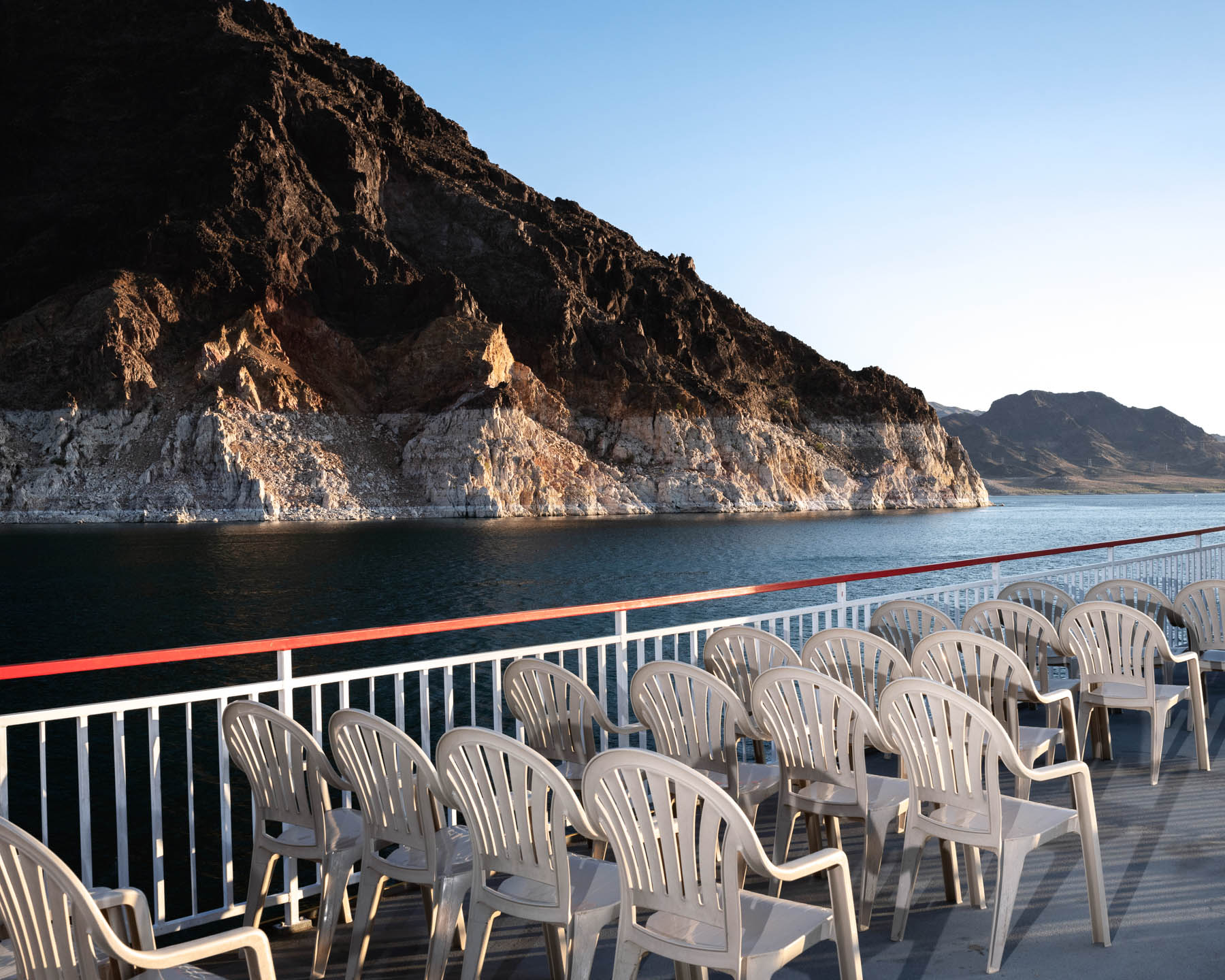
A view of the "bathtub ring," or high-water mark, from a largely empty Lake Mead Cruises boat on June 4. Nearly a week later, the water level reached its lowest point since being filled in the 1930s, after the construction of the Hoover Dam. Arizona farmers are expecting the first-ever cuts next year to their water supply from the mighty Colorado River. A contingency plan signed by Western states in 2019 will supplement some of the farmers' lost water.
Quang cảnh "vành đai bồn tắm" hay còn gọi là vạch nước cao, từ một chiếc thuyền trên Hồ Mead Cruises gần như trống rỗng vào ngày 4 tháng 6. Gần một tuần sau, mực nước đạt mức thấp nhất kể từ khi được lấp đầy vào những năm 1930, sau khi xây dựng đập Hoover. Nông dân Arizona đang mong đợi việc cắt giảm lần đầu tiên vào năm tới đối với nguồn cung cấp nước của họ từ sông Colorado hùng vĩ. Một kế hoạch dự phòng được các bang phương Tây ký vào năm 2019 sẽ bổ sung một số lượng nước bị mất của nông dân.
 47 heat-associated deaths, more than triple the figure confirmed by the end of the same period last year. Marquess had long wondered if this was how Ramer might die in Arizona: “I just didn’t think it was going to be this soon.”](https://assets.time.com/extreme-heat-drought/static/img/large/AF_USA_Heat_2021_05468.jpg)
Goodyear, Ariz.
Jody Marquess, 43, looks at the recliner where his stepfather John Ramer died on June 17. It was Marquess’s birthday, but he was concerned about the 69-year-old, who eschewed air-conditioning. “He had tough-guy syndrome,” Marquess says, recalling a “stubborn” and “very frugal” but also “honest and simple” man. When Marquess stopped by that day—the high reached 118°F—he installed a portable AC unit for Ramer, who was sleeping. Two hours later, when he returned to drop off ice cream, Ramer was dead. From April through July, Maricopa County confirmed 47 heat-associated deaths, more than triple the figure confirmed by the end of the same period last year. Marquess had long wondered if this was how Ramer might die in Arizona: “I just didn’t think it was going to be this soon.”
Global average temperatures have ticked up about 1.1°C since the Industrial Revolution, according to the IPCC, but that seemingly small number obscures the enormous and immediate spikes in temperature in particular places. The IPCC report, a collaboration among 234 authors, cites more than 14,000 studies and references, covering all the shifts that are occurring in the environment, from the way water circulates to the level of moisture in soil. At the core of all these changes is heat.
Heat waves that bring high temperatures that extend for days have become more frequent, and some areas, particularly vulnerable regions like the Arctic, are warming faster than others. These higher temperatures have a range of trickle-down effects: an altered jet stream, more intense drought and even increased precipitation, to name a few.
“It’s the combination of heat waves, drought conditions and also windy conditions that allow fire propagation,” says Paola Andrea Arias Gómez, an IPCC co-author and associate professor at the school of the environment at the University of Antioquia in Colombia. That’s led to record fire numbers: Last year California experienced the worst fire season on record; this year the state has experienced nearly three times the acreage burn compared with the same point in 2020.
Nhiệt độ trung bình của vùng lobal đã tăng lên khoảng 1,1 ° C kể từ cuộc Cách mạng Công nghiệp, theo IPCC, nhưng con số dường như nhỏ đó đã che khuất sự gia tăng nhiệt độ khổng lồ và tức thì ở những nơi cụ thể. Báo cáo của IPCC, sự hợp tác giữa 234 tác giả, trích dẫn hơn 14.000 nghiên cứu và tài liệu tham khảo, bao gồm tất cả những thay đổi đang xảy ra trong môi trường, từ cách nước lưu thông đến mức độ ẩm trong đất. Cốt lõi của tất cả những thay đổi này là nhiệt.
Các đợt nắng nóng kéo theo nhiệt độ cao kéo dài nhiều ngày đã trở nên thường xuyên hơn và một số khu vực, đặc biệt là các khu vực dễ bị tổn thương như Bắc Cực, đang ấm lên nhanh hơn các khu vực khác. Nhiệt độ cao hơn này có một loạt các hiệu ứng nhỏ giọt: dòng phản lực bị thay đổi, hạn hán khốc liệt hơn và thậm chí tăng lượng mưa, có thể kể đến một số loại.
Bất kỳ một trong những hiệu ứng gợn sóng đó đều sẽ tạo ra các vấn đề nghiêm trọng nếu nó tự tấn công, nhưng khi nhiều gợn sóng hạ cánh cùng một lúc, kết quả càng trở nên trầm trọng hơn. Đó là những gì đang xảy ra ngay bây giờ ở miền Tây Hoa Kỳ, nơi các cư dân đang trải qua điều mà IPCC gọi là “sự kiện cực đoan phức hợp”. Ở miền tây Hoa Kỳ trong năm nay, nắng nóng đã làm bốc hơi nguồn cung cấp nước cho nông dân và chủ trang trại — chưa kể các cộng đồng địa phương. Các quốc gia đã báo cáo hàng trăm trường hợp tử vong do thi thể đổ nát mà không được điều hòa nhiệt độ trong điều kiện nhiệt độ không thể kiểm soát được. Và nắng nóng đã dẫn đến hạn hán, khiến rừng khô héo và tạo ra những đám cháy rừng.
Paola Andrea Arias Gómez, đồng tác giả IPCC và phó giáo sư tại trường môi trường thuộc Đại học Antioquia ở Colombia, cho biết: “Đó là sự kết hợp của các đợt nắng nóng, điều kiện khô hạn và gió cho phép lan truyền lửa. Điều đó đã dẫn đến số lượng hỏa hoạn kỷ lục: Năm ngoái, California đã trải qua mùa hỏa hoạn tồi tệ nhất được ghi nhận; Năm nay, bang này đã trải qua gần ba lần diện tích bị đốt cháy so với cùng thời điểm vào năm 2020.
. The next day, calling the heat [“too dangerous,”](https://twitter.com/PDXParksandRec/status/1409592283477938177) the city’s parks-and-recreation department [closed](https://twitter.com/pdxparksandrec/status/1409592158458314752) outdoor pools after lifeguards suffered “heat-related illnesses.”](https://assets.time.com/extreme-heat-drought/static/img/large/AF_USA_Heat_2021_06789.jpg)
Portland, Ore.
Isaiah Vankova and Sofia Zambrano, both 18, stand on the bank of the Willamette River near Sellwood Riverfront Park on June 27. Record-shattering heat in Portland, where that day it was hotter than Dubai, would lead to canceled summer school programs and shuttered restaurants and other businesses. The next day, calling the heat “too dangerous,” the city’s parks-and-recreation department closed outdoor pools after lifeguards suffered “heat-related illnesses.”
Isaiah Vankova và Sofia Zambrano, 18 tuổi, đứng trên bờ sông Willamette gần Công viên Bờ sông Sellwood vào ngày 27 tháng 6. Cái nóng kỷ lục ở Portland, nơi mà ngày đó nóng hơn Dubai, sẽ khiến các chương trình học hè bị hủy bỏ và đóng cửa nhà hàng và các doanh nghiệp khác. Ngày hôm sau, gọi cái nóng là “quá nguy hiểm”, sở công viên và giải trí của thành phố đã đóng cửa các hồ bơi ngoài trời sau khi nhân viên cứu hộ mắc phải “bệnh liên quan đến nhiệt”.
 an [](https://assets.time.com/extreme-heat-drought/static/img/large/AF_USA_Heat_2021_04679.jpg)
Phoenix, Ariz.
Firefighters from Phoenix Fire Department Station 18 tend to a man who suffered a medical emergency, as well as subsequent burns to his body after falling on the scalding ground, on June 17. The city experienced an "unprecedented" 53 days at 110°F or warmer last year, when the Arizona Burn Center recorded 104 burn injuries related to the heat in June, July and August, marking the highest number since it began keeping track in 2000.
Các nhân viên cứu hỏa từ Sở Cứu hỏa Phoenix Trạm 18 có xu hướng tìm kiếm một người đàn ông bị cấp cứu y tế, cũng như các vết bỏng sau đó trên cơ thể anh ta sau khi ngã trên mặt đất bỏng, vào ngày 17 tháng 6. Thành phố đã trải qua 53 ngày "chưa từng có" ở 110 ° F hoặc ấm hơn vào năm ngoái, khi Trung tâm Bỏng Arizona ghi nhận 104 ca bỏng liên quan đến nắng nóng vào tháng 6, tháng 7 và tháng 8, đánh dấu con số cao nhất kể từ khi nó bắt đầu được theo dõi vào năm 2000.
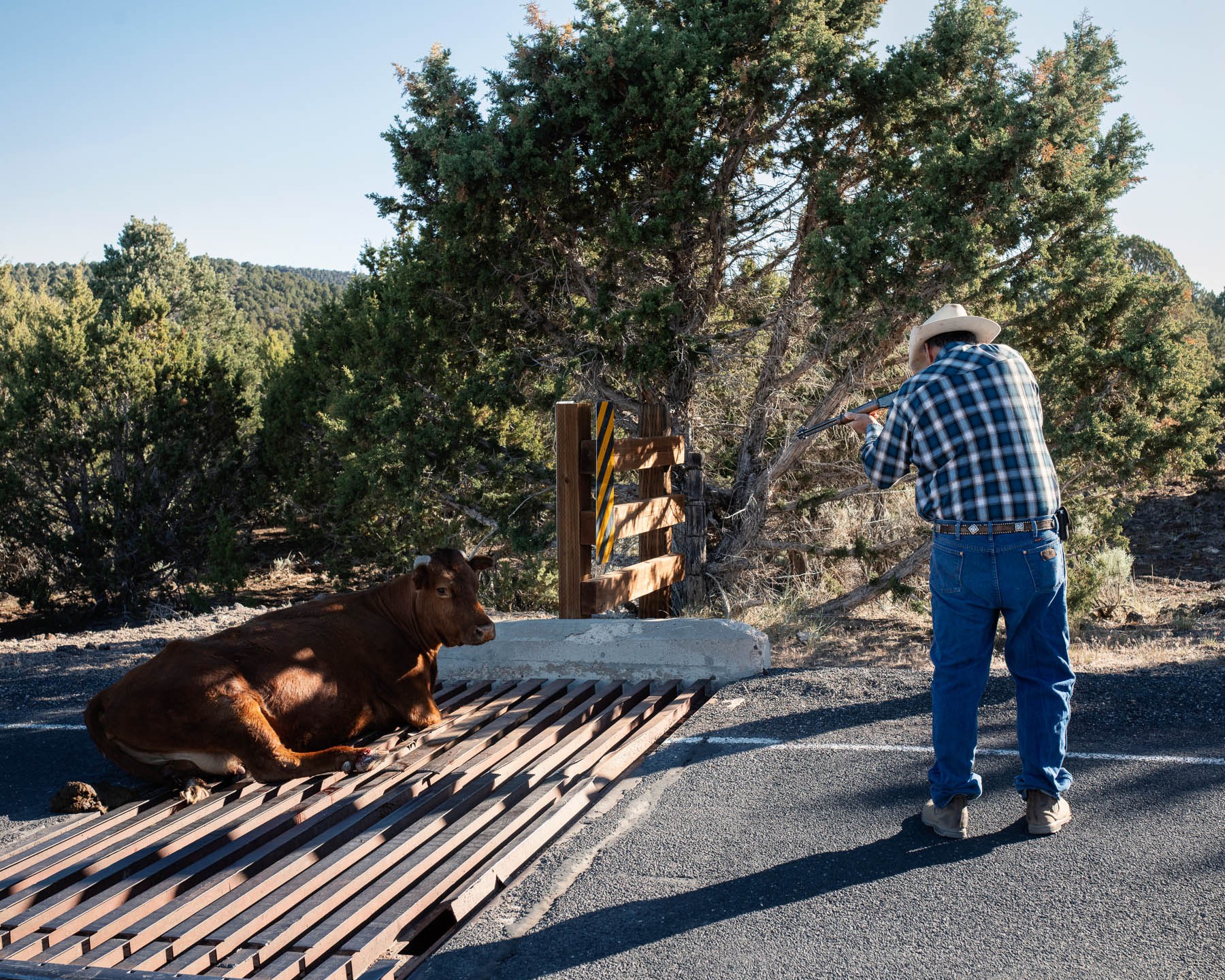
Near Pine Valley, Utah
On June 10, days after a rancher who runs approximately 800 head of cattle had moved many of them to higher ground for the summer, as he does annually, a straggler became stuck in a cattle grid. Unable to wrangle it free, the man then shot and removed it with members of his family. A year earlier, this area in Utah's southwest corner was "Abnormally Dry," the lowest classification of the U.S. Drought Monitor. This year, it was the highest: "Exceptional Drought."
Vào ngày 10 tháng 6, vài ngày sau khi một chủ trang trại chăn nuôi khoảng 800 con gia súc đã chuyển nhiều gia súc trong số chúng lên vùng đất cao hơn cho mùa hè, như ông vẫn làm hàng năm, một người mắc kẹt trong lưới gia súc. Không thể quấn lấy nó, người đàn ông sau đó đã bắn và gỡ nó ra cùng các thành viên trong gia đình mình. Một năm trước đó, khu vực ở góc tây nam của Utah này là "Khô Bất thường", mức phân loại thấp nhất của Cơ quan Giám sát Hạn hán Hoa Kỳ. Năm nay, nó là cao nhất: "Hạn hán đặc biệt."
. A global team of researchers later found it would have been](https://assets.time.com/extreme-heat-drought/static/img/large/AF_USA_Heat_2021_07188.jpg)
Portland, Ore.
Nora, a polar bear at the Oregon Zoo, during a record heat wave on June 28. The day's high would reach 116°F. A global team of researchers later found it would have been "virtually impossible without human-caused climate change." From 2010 to 2019, the high temperature recorded at Portland International Airport reached triple digits on 11 days, according to data tracked by The Oregonian/OregonLive. Since the beginning of 2020, it has happened on seven days—five of them over the past two months.
Nora, một con gấu Bắc Cực tại Vườn thú Oregon, trong đợt nắng nóng kỷ lục vào ngày 28 tháng 6. Mức cao nhất trong ngày sẽ lên tới 116 ° F. Một nhóm các nhà nghiên cứu toàn cầu sau đó đã phát hiện ra rằng điều đó sẽ là "hầu như không thể nếu không có sự thay đổi khí hậu do con người gây ra." Từ năm 2010 đến năm 2019, nhiệt độ cao được ghi nhận tại Sân bay Quốc tế Portland đạt ba con số trong 11 ngày, theo dữ liệu được theo dõi bởi The Oregonian / OregonLive. Kể từ đầu năm 2020, nó đã xảy ra vào bảy ngày — năm ngày trong số đó trong hai tháng qua.
 when the temperature reached 112°F.](https://assets.time.com/extreme-heat-drought/static/img/large/AF_USA_Heat_2021_06437.jpg)
Portland, Ore.
Rachel DeHart donates a bag of ice to a cooling station on June 27. One day after Portland hit 108°F, setting a new all-time high, the record fell again when the temperature reached 112°F.
Rachel DeHart tặng một túi đá cho một trạm làm mát vào ngày 27 tháng 6. Một ngày sau khi Portland đạt 108 ° F, lập mức cao nhất mọi thời đại mới, kỷ lục lại giảm xuống khi nhiệt độ đạt 112 ° F.
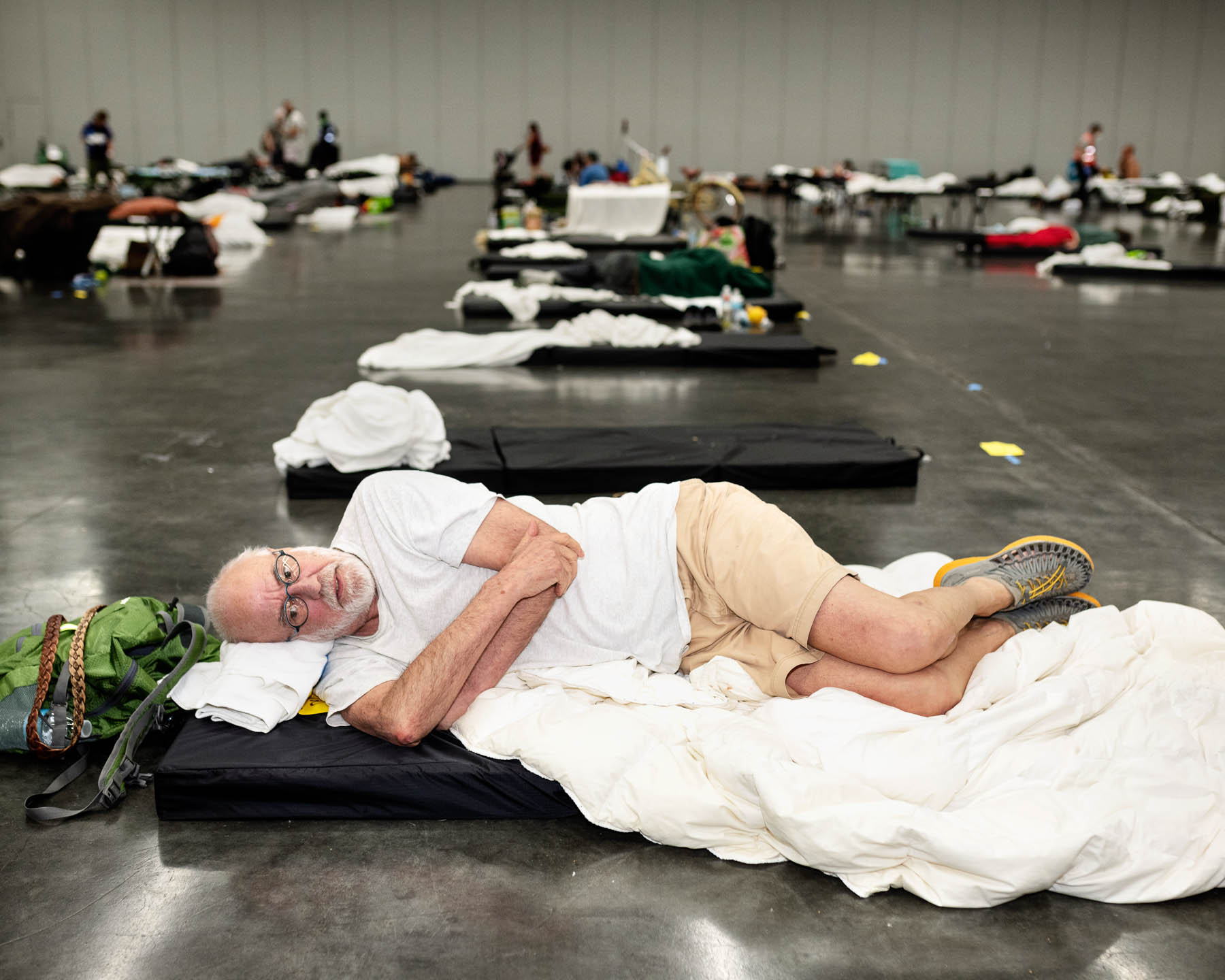
Portland, Ore.
As temperatures soared in late June, Dennis Henry, a 71-year-old with a heart condition that makes breathing more difficult, left his “lovely old apartment house” that lacks air conditioning and hopped on a bus to the Oregon Convention Center, where a 24-hour cooling station was operating. “Yesterday, I thought I could make it through the day and the night, but I looked at the projections for today and the day after, and I decided I better get my tail down here and make sure I get a spot,” Henry said on June 27. “They’re very nice here... The food’s even good,” he adds. “They keep it slightly colder than it needs to be. I go out and warm up every once in a while for a little bit. Which is ridiculous! Isn’t it ironic?”
The U.S. West is not alone in inhabiting dire climate straits. For the first time, the IPCC this year offered a comprehensive analysis of climate change at the regional level. Every region on the planet has already taken a hit from warming in one form or another, according to the report.
In places where people are already facing devastation, the scale of the climate-changed reality is starting to seep in. In the air-conditioned Oregon Convention Center in Portland, Dennis Henry, 71, tells TIME that he would consider moving if the heat waves became a regular occurrence. Henry had taken shelter in the cavernous meeting hall—a temporary fix, he acknowledges. “If the situation became extreme, where this was semi-normal ... no, I wouldn’t be here,” he says. But at the same time, “I can’t plan where to move, because who knows what they’re going to be like.”
Khi nhiệt độ tăng vọt vào cuối tháng 6, Dennis Henry, một người đàn ông 71 tuổi bị bệnh tim khiến việc thở khó khăn hơn, đã rời khỏi “căn nhà chung cư cũ xinh xắn” thiếu điều hòa và bắt xe buýt đến Trung tâm Hội nghị Oregon, nơi một trạm làm mát 24 giờ đã hoạt động. “Hôm qua, tôi nghĩ rằng mình có thể vượt qua cả ngày lẫn đêm, nhưng tôi đã xem xét các dự đoán cho ngày hôm nay và ngày kia, và tôi quyết định tốt hơn là nên tìm hiểu kỹ càng ở đây và đảm bảo rằng tôi sẽ có được một chỗ,” Henry nói vào ngày 27 tháng 6. “Ở đây họ rất tuyệt ... Đồ ăn còn ngon nữa,” anh ấy nói thêm. “Họ giữ cho nó hơi lạnh hơn mức cần thiết. Thỉnh thoảng tôi đi ra ngoài và sưởi ấm một chút. Thật là nực cười! Có phải điều đó thật mỉa mai không? "
"ĐÂY LÀ TREMENDOUS TRỢ GIÚP."
Miền Tây Hoa Kỳ không đơn độc trong các eo biển khí hậu thảm khốc. Lần đầu tiên, IPCC năm nay đưa ra phân tích toàn diện về biến đổi khí hậu ở cấp khu vực. Theo báo cáo, mọi khu vực trên hành tinh đều đã phải hứng chịu hậu quả từ việc nóng lên dưới hình thức này hay hình thức khác.
Ở những nơi mà con người đang phải đối mặt với sự tàn phá, quy mô của thực tế biến đổi khí hậu đang bắt đầu xâm nhập. Tại Trung tâm Hội nghị Oregon có máy lạnh ở Portland, Dennis Henry, 71 tuổi, nói với TIME rằng ông sẽ cân nhắc việc di chuyển nếu các đợt nắng nóng đã trở thành chuyện thường xuyên. Henry đã trú ẩn trong hội trường hang động - một giải pháp tạm thời, anh thừa nhận. “Nếu tình hình trở nên cực đoan, nơi điều này là bán bình thường ... không, tôi sẽ không ở đây,” anh nói. Nhưng đồng thời, "Tôi không thể lên kế hoạch chuyển đi đâu, vì ai mà biết được họ sẽ như thế nào."
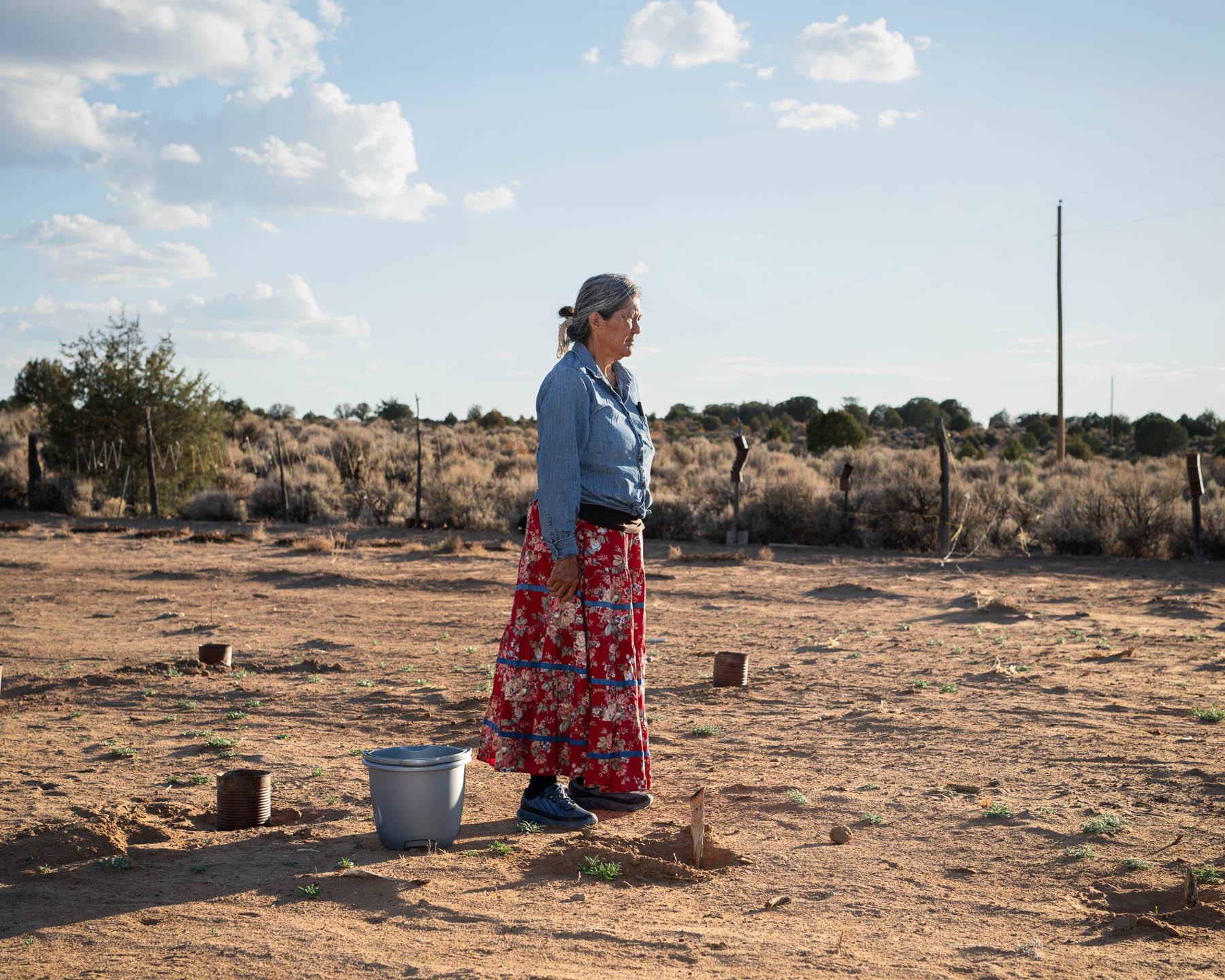
Hard Rock Chapter, Ariz.
Lorraine Herder, 68, stands on her recently planted cornfield in the Black Mesa region of Navajo Nation on June 24. When she was growing up, the family brought its livestock to nearby springs for water. With those sources long gone after decades of local coal operations and rising temperatures, “this area is all dried up,” she says. Each day, her family leaves home to fill a 275-gal. vat—at 1¢ per gal. Last year they spent $5,000 on supplemental feed for the animals.
Bà Lorraine Herder, 68 tuổi, đứng trên cánh đồng ngô mới trồng của bà ở vùng Black Mesa thuộc Quốc gia Navajo vào ngày 24 tháng 6. Khi bà lớn lên, gia đình đưa gia súc đến các con suối gần đó để lấy nước. Với những nguồn đó đã bị biến mất từ lâu sau nhiều thập kỷ hoạt động than tại địa phương và nhiệt độ tăng cao, “khu vực này đã cạn kiệt”, cô nói. Mỗi ngày, gia đình cô rời nhà để lấp đầy 275 gal. vat — ở mức 1 ¢ mỗi gal. Năm ngoái, họ đã chi 5.000 đô la cho thức ăn bổ sung cho động vật.
](https://assets.time.com/extreme-heat-drought/static/img/large/AF_USA_Heat_2021_07995.jpg)
Lake Oroville, Calif.
A view of the lake through trees burned during a previous fire season on July 2, when the elevation was recorded at about 680 ft. above sea level. California's water resources department stated "extremely dry" soils and "climate change-induced early warm temperatures" led to a dramatic reduction in runoff this past spring. In early August, in a move the state said it anticipated, the hydroelectric plant that is fed by the reservoir was taken offline for the first time after water levels dropped below 645 ft., the previous low set in 1977. By late October, the state projects, the elevation could sink to as low as 620 ft.
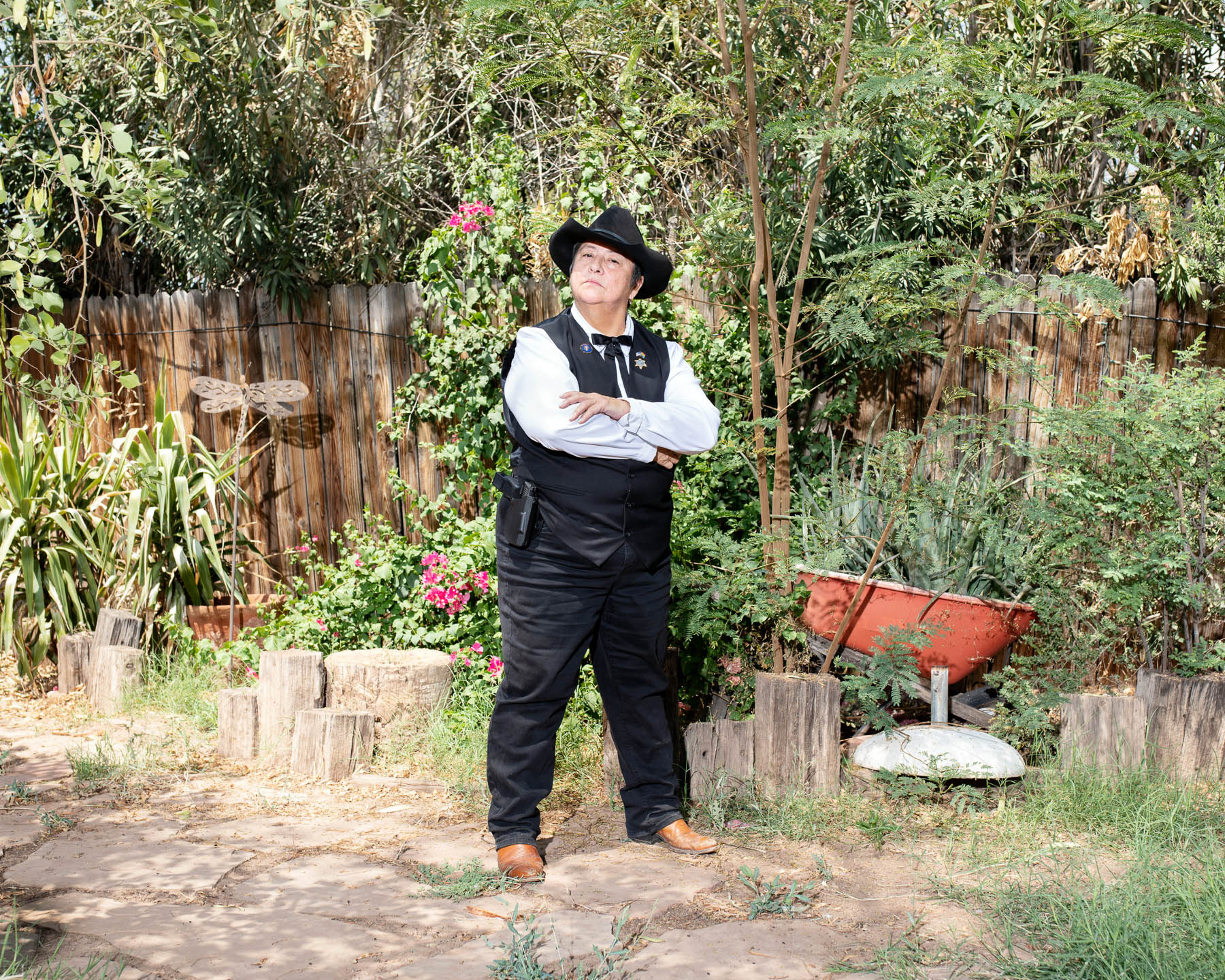
Phoenix, Ariz.
Constable Darlene Martinez has lived in Phoenix long enough—since the mid 1980s—“to see the climate change.” Martinez’s experience back then, as a carpenter who suffered from heatstroke during her first year in Arizona, has informed her approach today when carrying out orders of the court: evictions, warrants, orders of protection and more. “Evicting people in the heat,” she says, “is the hardest thing to do.” But Martinez, who hauls around cases of water in her vehicle, says she makes sure they have a means of transportation and another place to go. In the summer, she starts evictions at around 7 a.m., hours earlier than she did a decade ago. By the end of her day, the clothes under her bulletproof vest are “completely soaked.” Her signature black hat provides shade, but it hasn’t escaped unharmed. “The salt of my sweat wore out the rim,” she says. “After a year, I had to have it replaced.”
"I DON'T WANT TO EVICT THEM AND PUT THEM ON THE STREET."
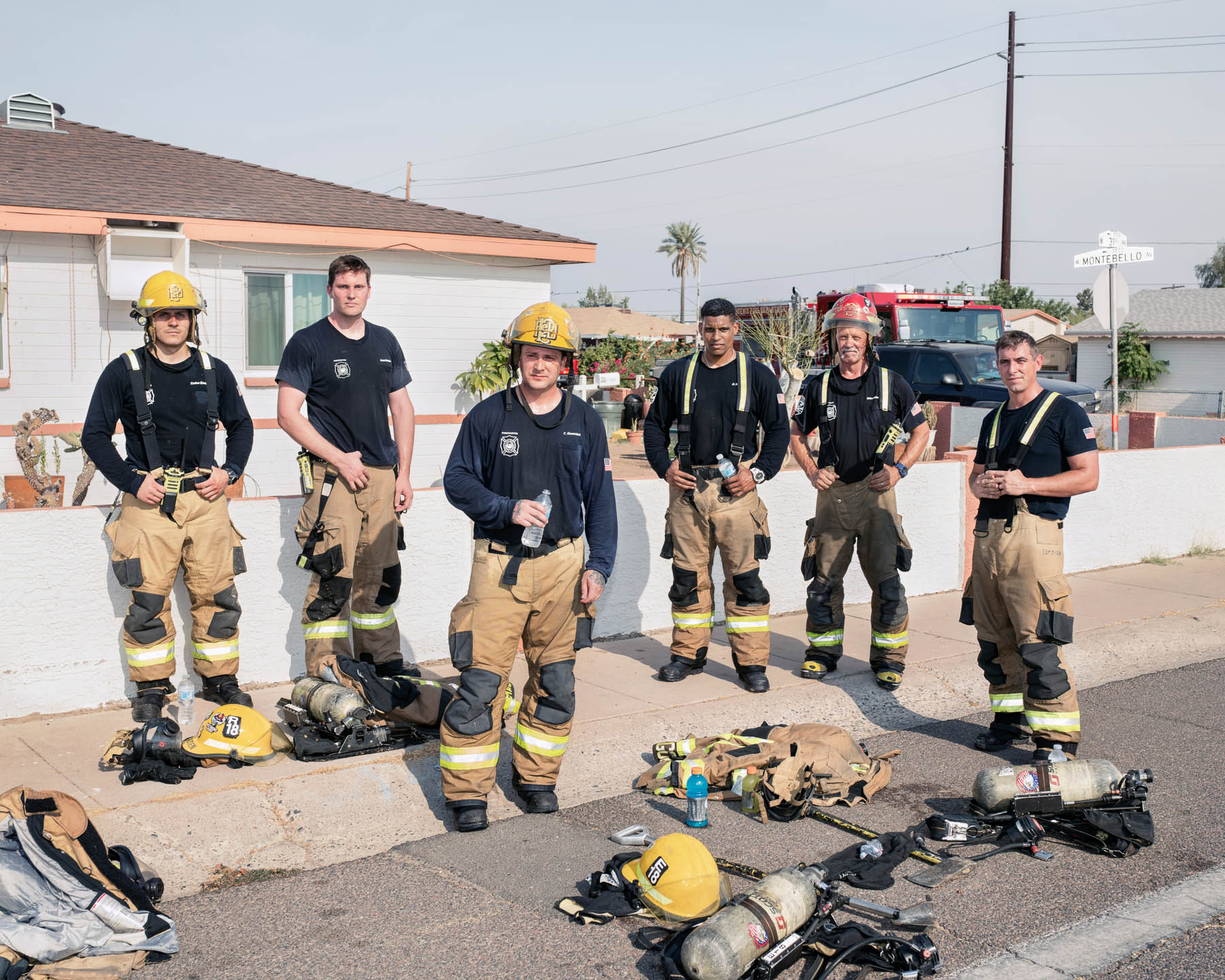
Phoenix, Ariz.
Firefighters from Phoenix Fire Department Station 18 stand for a portrait after a house fire on June 16, a day when the high was 115°F. “The heat definitely intensifies everything we do this time of year,” says Capt. Mike Adelman, second from right, who has spent 27 years with the department. The firefighters often perform activities similar to what they will encounter on site as a means of confronting the summer’s highest temperatures. They also work to control their breathing and pay strict attention to their situational awareness, so as not to expend energy they’ll need when calls come in. “What it comes down to is staying trained up, staying acclimated to the heat and understanding the environment that we live in and that we work in, and really just being able to overcome those obstacles,” says Richie Robnett, third from right. “A big part of this job is, you’ve got to get comfortable being uncomfortable.”
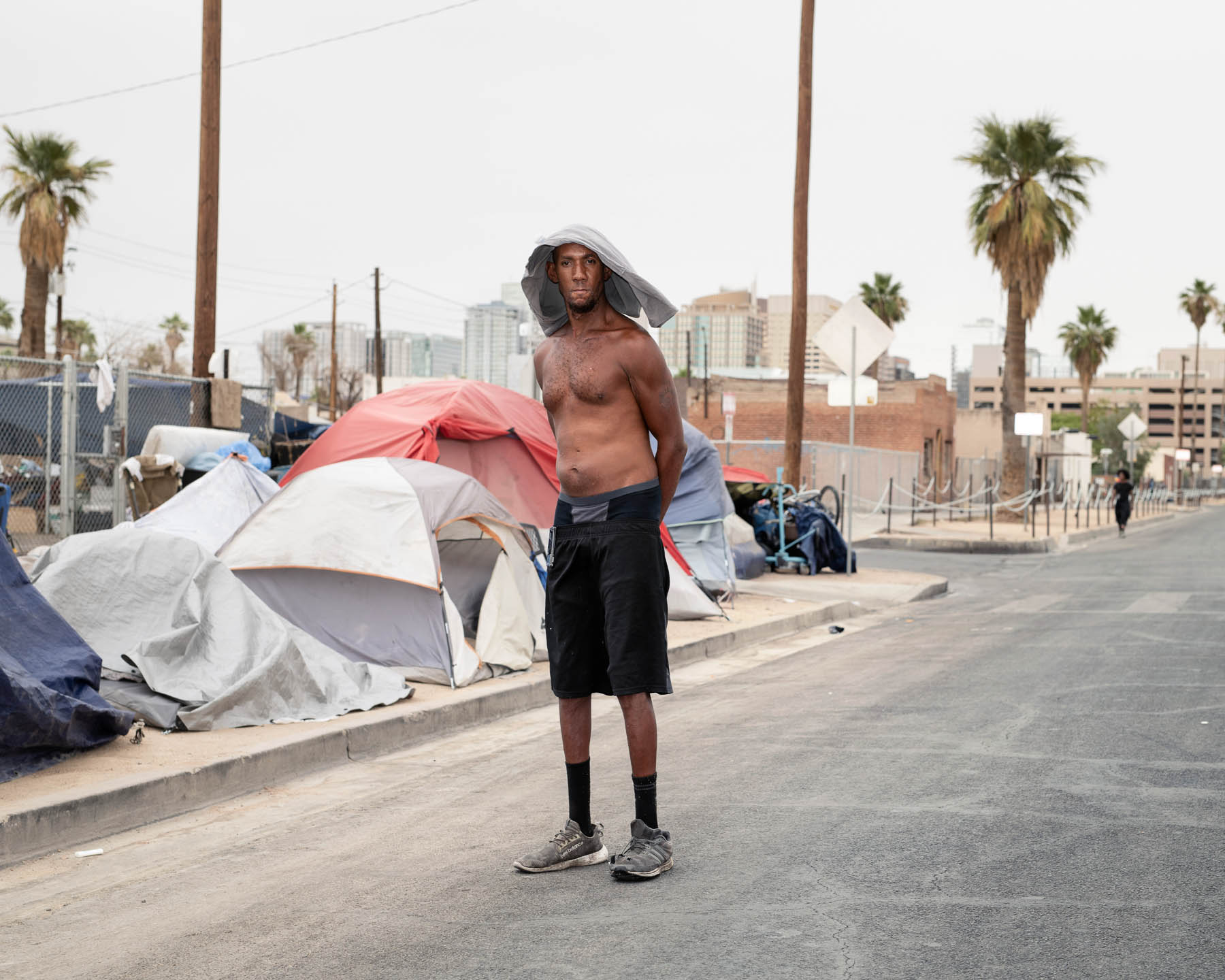
Phoenix, Ariz.
William Calvin “Slim” Sterling stands near his tent on June 14. “It feels like God is holding a magnifying glass to your legs,” said the 39-year-old, who suffered from heatstroke months ago, during what became Phoenix’s hottest June on record. “I can feel the sun cooking my shoulder blades.” For relief, he covers his head with a wet shirt, uses a battery-powered fan and stays as hydrated as possible. “It’s a war zone,” he says. At a nearby shelter with shade, “it’s like peace.”
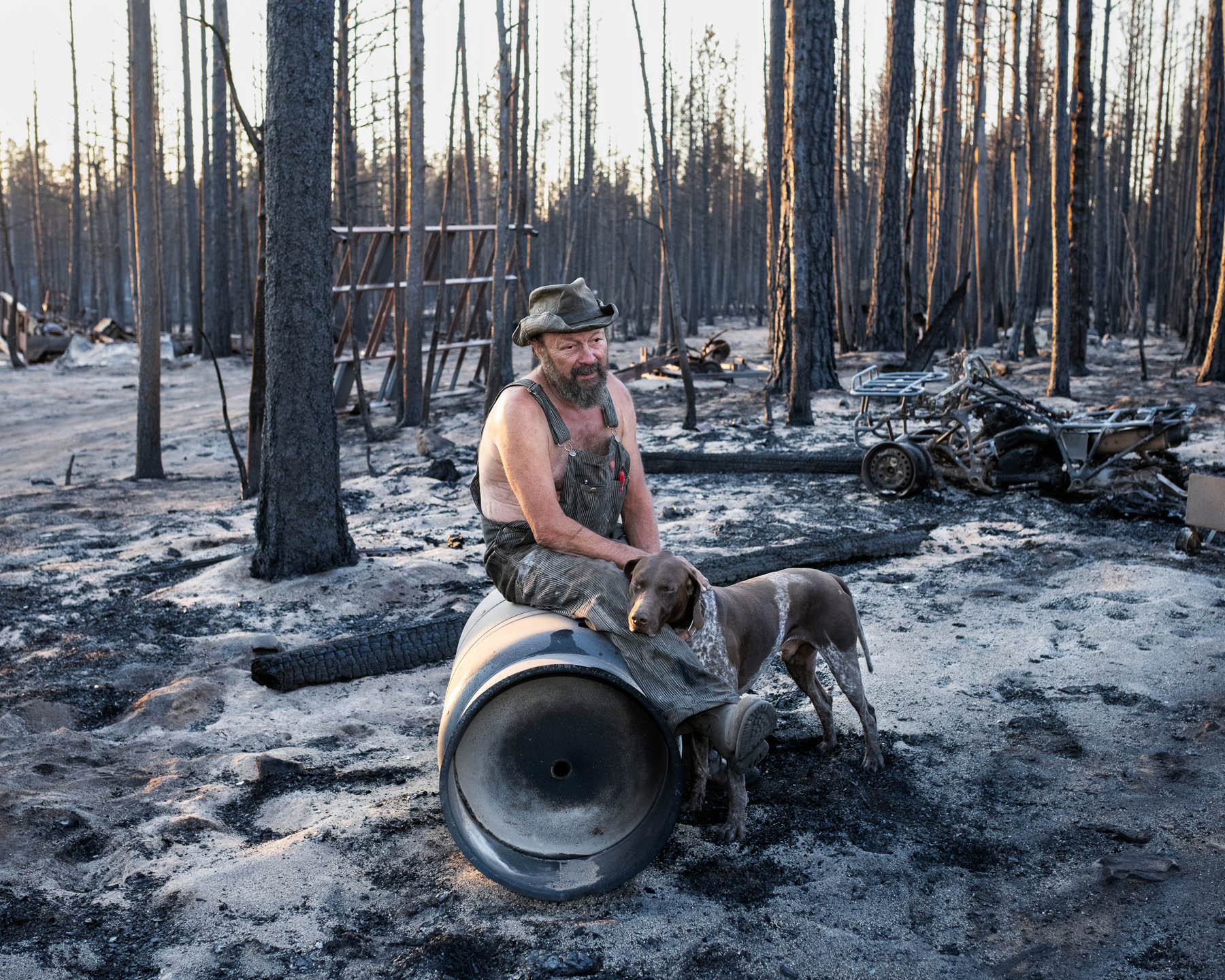
Sycan Estates, Ore.
Jeff Whited sits among his destroyed belongings on July 22. The Bootleg Fire arrived “just like a freight train,” says Whited. “It looks like a freaking bomb went off.” The 63-year-old had been helping clean up the wreckage of his brother’s burned-down house when flames reached his own. Guitars and amplifiers, snowmobiles and trucks, engine parts, chain saws, a huge cache of hand tools and much more—all gone, Whited says. “This sure was a beautiful place,” he says. “It doesn’t leave a beautiful memory with me, not this picture of it.” At the grave of his partner on his 12-acre property, wind chimes used to hang in the trees. Whited recalls asking why she wanted so many of them, to which she replied, “When I'm gone, baby, you’ll know I’m still there when you hear ’em.” After the fire, he says, “I can’t hear one. They’re gone. Every wind chime.”
It’s too soon, though, to completely throw in the towel. We may have almost certainly locked in some amount of global warming, but we still have choices to make that can determine how far past the red line we go. And every fraction of a degree matters.
Policymakers from around the globe are currently gearing up for global climate talks meant to put the world on track to keep temperatures from rising more than 1.5°C by the end of the century. The IPCC report “will give ammunition to those of us who are saying this is a crisis,” says Nat Keohane, president of the Center for Climate and Energy Solutions. But so too should the stories of those on the ground who already have lost homes, livelihoods and loved ones.
![On June 18, Jill Langham and her friend Geoffrey-Martin Cyr planned to have drinks together in the evening. The desert city was experiencing a heat wave: for 43 consecutive days in June and July, temperatures hit 100°F or higher. The soles burned off Langham’s shoes that day, on which the high was 119°F. Cyr planned to lie out near a pool before meeting up. At close to 5 p.m., he texted to say he was “winded” but on his way. He never arrived. Langham didn’t think much of his absence—their plans were casual, and they were due to have brunch that weekend anyway. She later learned Cyr, 55, had collapsed and was transported to a hospital, where he died the next day from complications of heatstroke. “I really wish I had sent him a photo of those [shoes] and said, ‘Hey, be careful out there,’” she says. “Would he have listened? He was a sun worshipper.”](https://assets.time.com/extreme-heat-drought/static/img/large/AF_USA_Heat_2021_08895.jpg)
Palm Springs, Calif.
On June 18, Jill Langham and her friend Geoffrey-Martin Cyr planned to have drinks together in the evening. The desert city was experiencing a heat wave: for 43 consecutive days in June and July, temperatures hit 100°F or higher. The soles burned off Langham’s shoes that day, on which the high was 119°F. Cyr planned to lie out near a pool before meeting up. At close to 5 p.m., he texted to say he was “winded” but on his way. He never arrived. Langham didn’t think much of his absence—their plans were casual, and they were due to have brunch that weekend anyway. She later learned Cyr, 55, had collapsed and was transported to a hospital, where he died the next day from complications of heatstroke. “I really wish I had sent him a photo of those [shoes] and said, ‘Hey, be careful out there,’” she says. “Would he have listened? He was a sun worshipper.”
 of its capacity. “This drought is real. Climate change is real,” Governor Gavin Newsom said three weeks later, [standing](https://www.youtube.com/watch?v=uR4Smmt2CGo) bone dry in what in typical years would have been waist-deep water. “If you don’t believe in science, please, you’ve got to believe your own eyes.” By Aug. 14, the water had dropped 6% more.](https://assets.time.com/extreme-heat-drought/static/img/large/AF_USA_Heat_2021_07774.jpg)
El Dorado Hills, Calif.
Boat docks rest on the floor of Folsom Lake, a reservoir on the American River in the Sierra Nevada foothills about 25 miles east of Sacramento. On June 30, as California ended one of its driest rain seasons on record, the reservoir registered just 30% of its capacity. “This drought is real. Climate change is real,” Governor Gavin Newsom said three weeks later, standing bone dry in what in typical years would have been waist-deep water. “If you don’t believe in science, please, you’ve got to believe your own eyes.” By Aug. 14, the water had dropped 6% more.
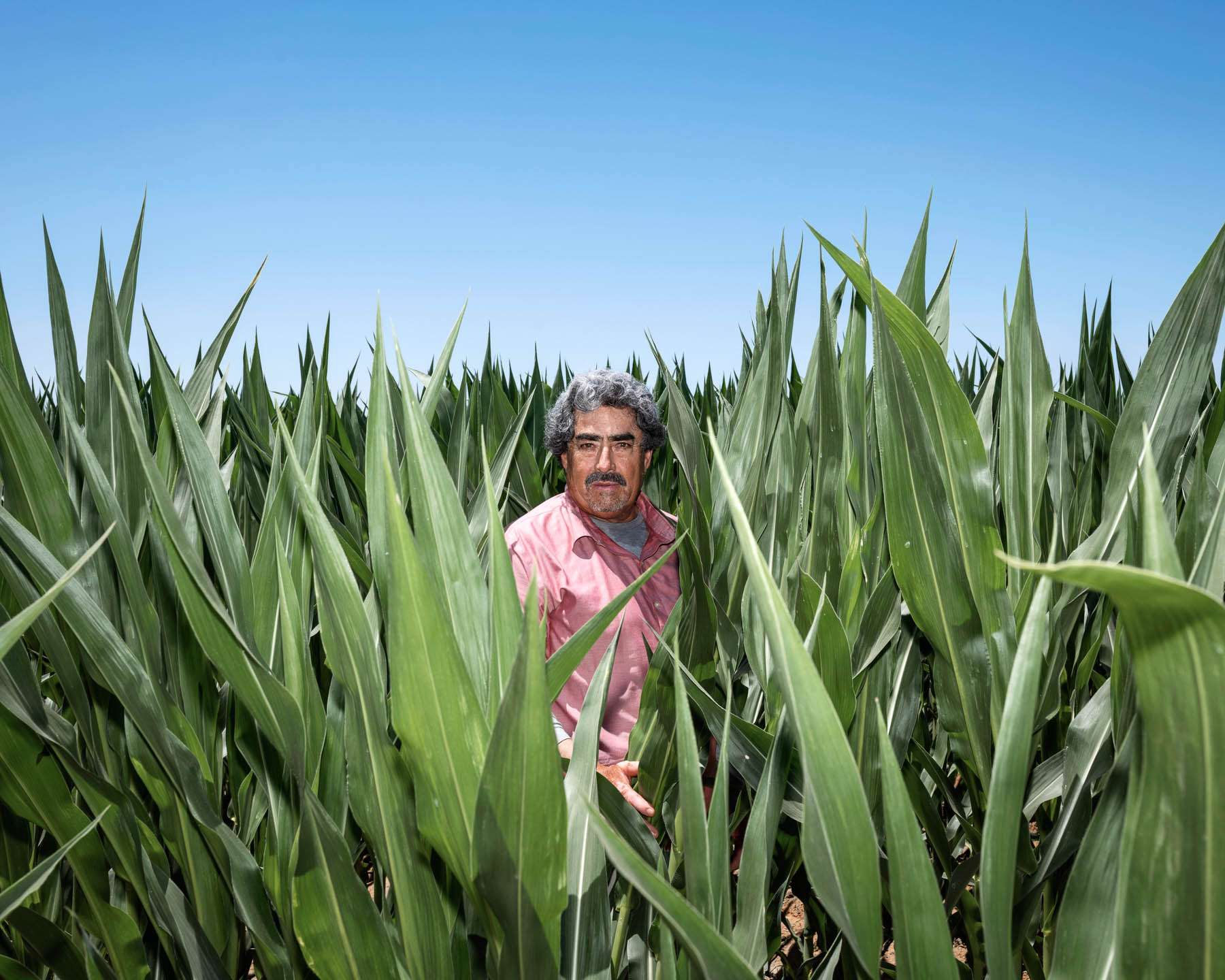
Pixley, Calif.
Guillermo Gomez, a U.S. resident born in Mexico, stands for a portrait in a field on Jer-Z-Boyz Ranch, where he makes his living as an irrigation worker, on July 4. Gomez has worked in this area for the past 24 years. "We didn't plant 220 acres because there wasn't enough water," Gomez says. "This is the worst drought I've seen."
 to have sunk more than 11 ft. due to decades of groundwater extraction. Newsom has called on Californians to [voluntarily reduce](https://www.gov.ca.gov/2021/07/08/as-drought-conditions-intensify-governor-newsom-calls-on-californians-to-take-simple-actions-to-conserve-water/) their water use by 15%.](https://assets.time.com/extreme-heat-drought/static/img/large/AF_USA_Heat_2021_08653.jpg)
Near Corcoran, Calif.
Billowing dust rises behind a truck driving over a barren field on July 5. Water shortages prevented the land from being planted this season, as the drought choked off water to farms across the state. Some land in the surrounding area is reported to have sunk more than 11 ft. due to decades of groundwater extraction. Newsom has called on Californians to voluntarily reduce their water use by 15%.
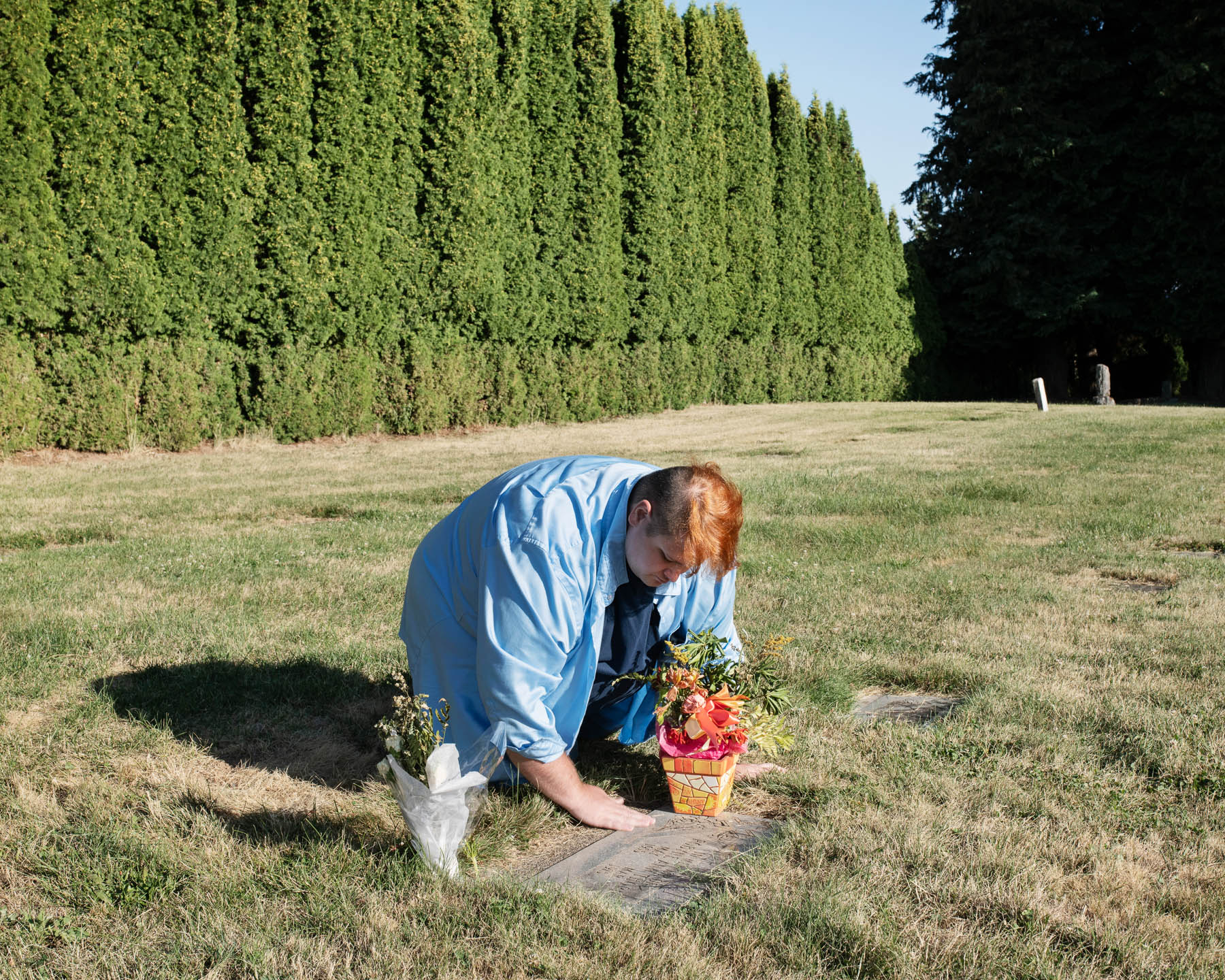
White Salmon, Wash.
Shane Brown, 35, visits the grave of his mother Jollene Brown at Klickitat County Cemetery District No. 1 on July 24. As a heat dome settled over the Pacific Northwest in late June, Jollene’s air conditioner wasn’t working properly, so he bought her a “swamp cooler”—an affordable device that cools the air through the evaporation of water. On the night of June 27, she told Shane, the air was so hot in her apartment that the cooler needed to be constantly refilled because the water evaporated so quickly. Shane said he would get her a new AC. The next morning, she wasn’t picking up his calls. After arriving at her home, Shane found her “just sitting in her recliner with her head to the side, like she had just fallen asleep,” he says. “Jolly,” 67, was full of opinions but not judgmental, loved Dolly Parton and Patsy Cline and puffins, and was among at least 60 people in Portland (and hundreds in the region) who died from hyperthermia during the heat wave. Shane called 911 and ran to a neighbor until police arrived. Later, while waiting for the medical examiner, he sat in the room with his mother “just because I wanted to be near her,” he says. “I didn’t want to leave her alone in the hot room.”
"SHE LOVED PRETTY MUCH ANYTHING SWEET AND HEARTFELT."
By Time.com
Các bài viết khác
- Vài nét Dự báo thời đại phục hưng và khai sáng của loài người sau đại dịch Corona-2019.7-2021(khởi đầu từ tháng 9 năm giáp thìn 2024) (25.06.2021)
- Từ sự kiện Tổng biên tập báo TIME Greta Thunberg là Nhân vật của năm 2019 đến báo cáo Biến đổi khí hậu Phúc trình của IPCC báo động đỏ cho nhân loại 82021 (15.01.2020)
- Hỗn loạn ở Afghanistan là thất bại rõ ràng của chính quyền Biden (24.08.2021)
- Những điều chưa biết về đất hiếm mà Trung Quốc dọa dùng làm vũ khí (24.08.2021)
- Nghịch lý giá nhà so với thu nhập người dân tại TP.HCM (24.08.2021)






















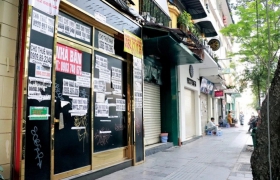
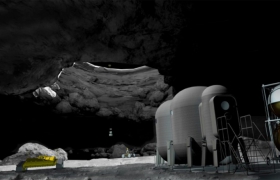
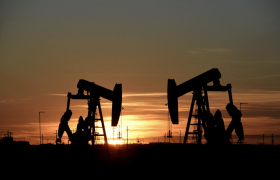
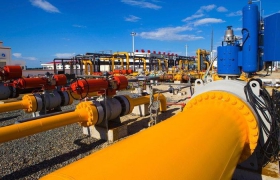

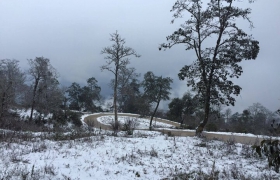

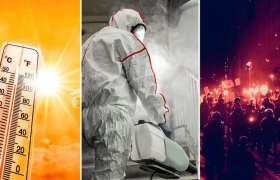




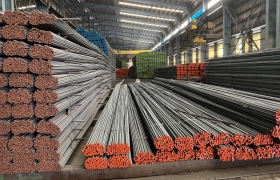















 Yahoo:
Yahoo: 